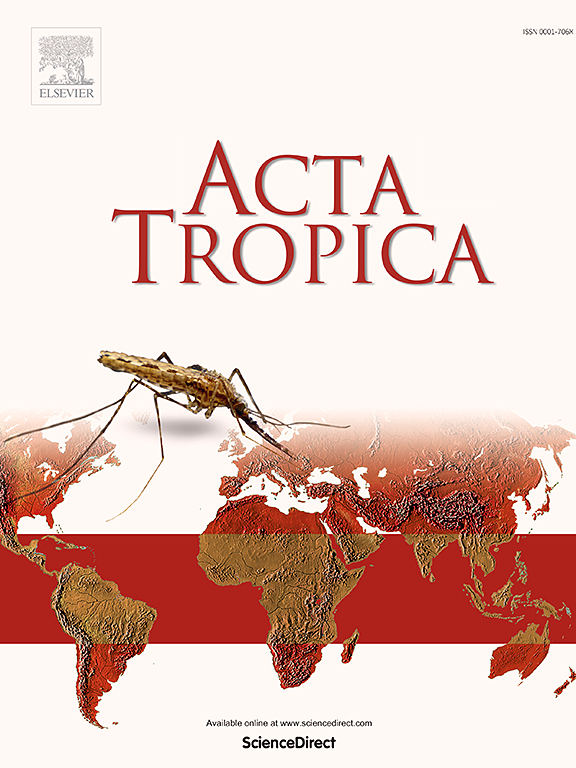First molecular detection of Babesia bigemina in horseflies from Uruguay
IF 2.1
3区 医学
Q2 PARASITOLOGY
引用次数: 0
Abstract
Bovine babesiosis and anaplasmosis are primarily transmitted by the biological vector Rhipicephalus microplus. However, Anaplasma marginale may also be mechanically transmitted through the bites of haematophagous flies such as tabanids. While biological transmission by ticks is the predominant route for Babesia species, some reports suggest that mechanical transmission via fomites contaminated with merozoites may occur. Additionally, mechanical vectors such as tabanids may contribute to the spread of the disease. This study investigated the presence of Babesia bigemina and Babesia bovis in tabanids from three localities in Uruguay previously evaluated for the presence of A. marginale. We performed PCR amplification targeting the Rap-1a and gp45 genes, followed by Sanger sequencing. Our findings revealed that 4.21 % of the tabanids tested positive for B. bigemina, with the highest prevalence in Tacuarembó (28.57 %), followed by Paysandú (3.22 %) and Colonia (1.75 %). Dasybasis missionum from Tacuarembó, Poeciloderas lindneri from Paysandú, and Tabanus sp. from Colonia were positive. Additionally, a co-detection rate of 2 % with A. marginale was observed. These findings underscore the potential role of tabanids as vectors for Babesia bigemina, emphasizing the need for integrated vector control strategies in livestock management.

乌拉圭马蝇中首次发现双巴贝斯虫
牛巴贝斯虫病和无形体病主要由生物媒介微头虫传播。然而,边缘无原体也可能通过吸血蝇(如虻)的叮咬机械传播。虽然蜱虫的生物传播是巴贝斯虫的主要途径,但一些报告表明,通过被分殖子污染的污染物进行机械传播也可能发生。此外,机械媒介,如虻,可能有助于疾病的传播。本研究调查了乌拉圭三个地区tabanids中存在的双巴贝斯虫和牛巴贝斯虫,这些tabanids之前被评估为存在边缘巴贝斯虫。我们对rapa -1a和gp45基因进行PCR扩增,然后进行Sanger测序。结果显示,有4.21%的tabanids检测阳性,其中Tacuarembó(28.57%)阳性率最高,其次是Paysandú(3.22%)和Colonia(1.75%)。来自Tacuarembó的Dasybasis missionum、来自Paysandú的Poeciloderas lindneri和来自Colonia的Tabanus sp呈阳性。此外,与边缘弧菌的共同检出率为2%。这些发现强调了虻作为双巴贝虫病媒介的潜在作用,强调了在牲畜管理中采取综合媒介控制策略的必要性。
本文章由计算机程序翻译,如有差异,请以英文原文为准。
求助全文
约1分钟内获得全文
求助全文
来源期刊

Acta tropica
医学-寄生虫学
CiteScore
5.40
自引率
11.10%
发文量
383
审稿时长
37 days
期刊介绍:
Acta Tropica, is an international journal on infectious diseases that covers public health sciences and biomedical research with particular emphasis on topics relevant to human and animal health in the tropics and the subtropics.
 求助内容:
求助内容: 应助结果提醒方式:
应助结果提醒方式:


